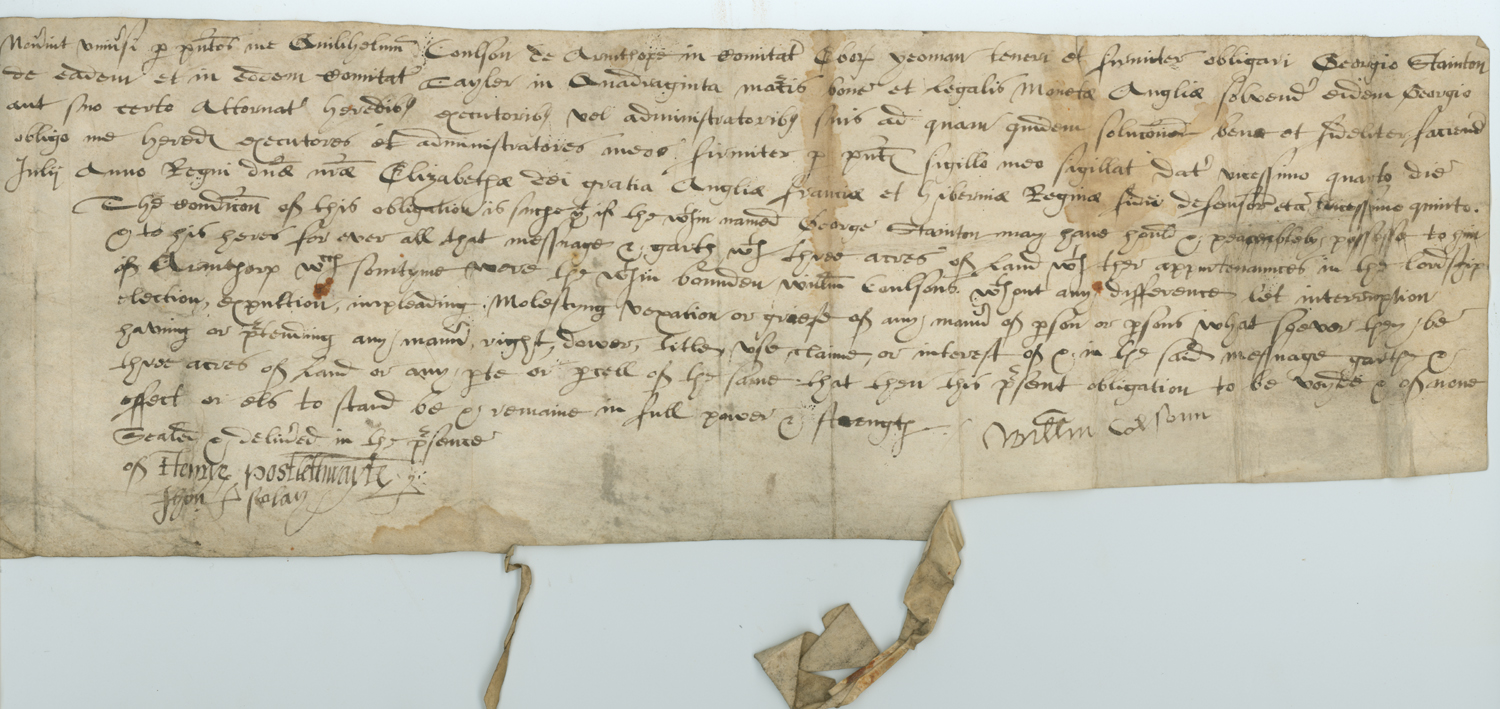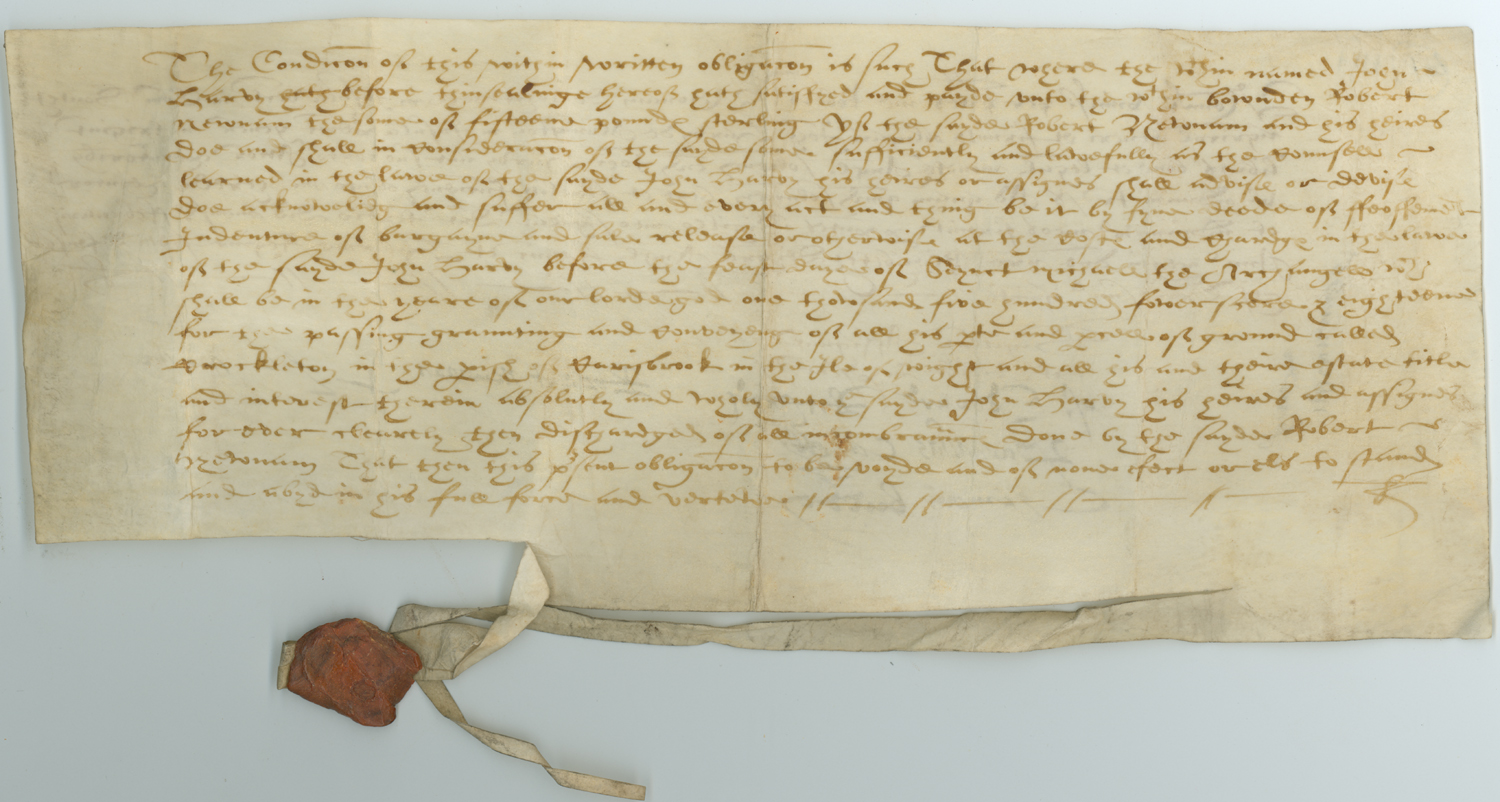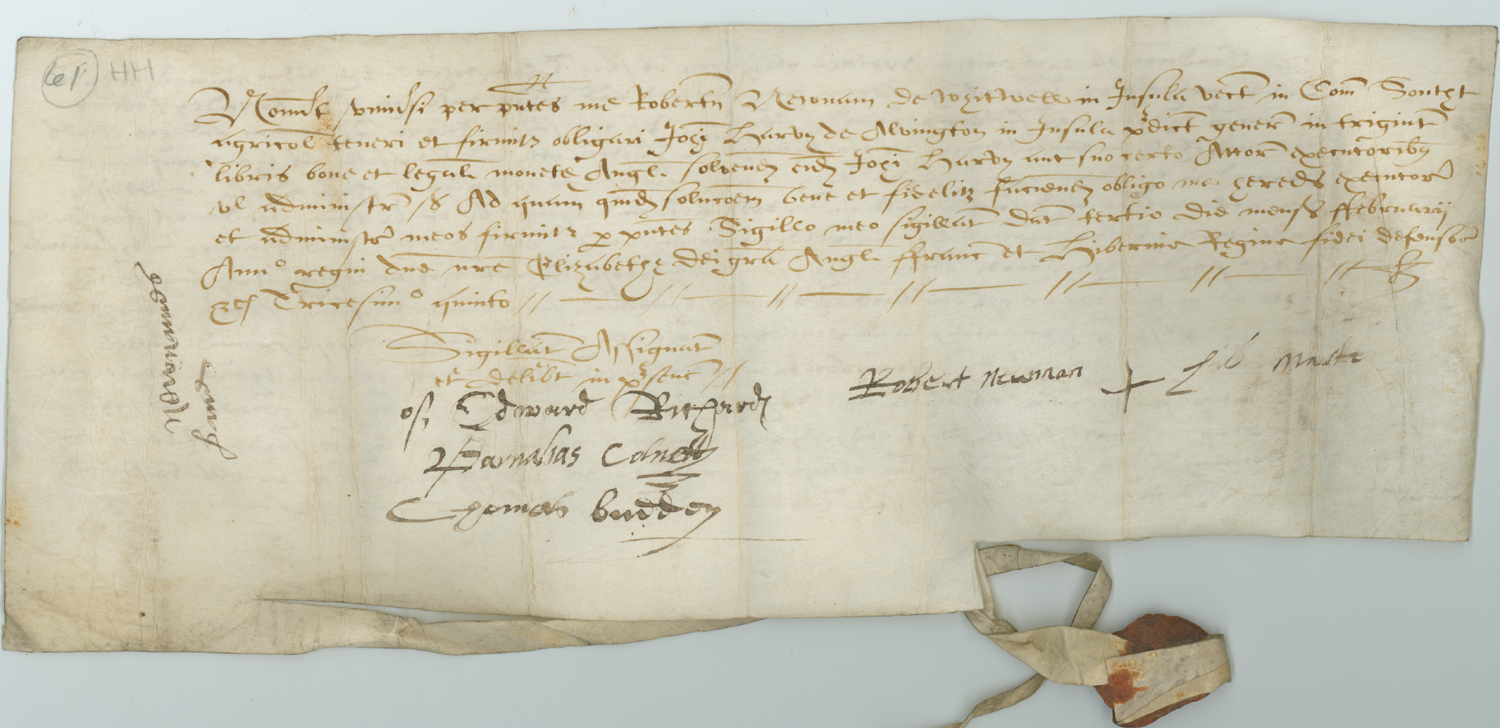In the last post, you might have noticed mentions of "ties" or even seen that some examples have what appears to be a second seal tag. The example below is a fine example from the 11th Century.




Writ of William II
1095, King's Cliffe
Seal: Great Seal in white wax
Wrapping: Tie remains. 3 vertical and 1 horizontal fold
(Burgley House)
1095, King's Cliffe
Seal: Great Seal in white wax
Wrapping: Tie remains. 3 vertical and 1 horizontal fold
(Burgley House)
Below the text, the parchment is slit into two narrow tounges, one holds the seal and the other is used to tie the doccument closed. It's generally called in the literature by the highly technical term of "a tie". You can see many of the standard features exhibited by 11th C wrapping ties here - the tie is long (the width of the document) and narrow, even if the seal tag is wider. The tie is located lower on the parchment thatn the seal tag. The folds in the parchment probably date from when it was created, the doccument being folded up and tied closed with the tie before being sent to the person it is adressed to. In fact if you look at the back (second image) of the royal writ above, you can more clearly see the fold marks, and a person's name, presumably the recipient.
So how did this habbit of folding up a writ or other doccument develop? Well, actually, rather than develop, this is a relic of the wax sealed letter. Although the writ is not longer sealed closed, people were still used to the king's word arriving in a folded letter. The tie was simply a way of keeping the doccument closed when there was no longer a blob of wax to keep the doccumnet sealed. And actually keeping a writ folded up was probably a better way of preserving it in a easy to store form than a long scrappy piece of paper.
The ever informative medieval writing website delves more deeply and provides more examples of the sealed 'letters close' from which these habbits developed. She uses the term letter close only for letters which are sealed closed with wax (as I shall), but points out that any doccument presented folded in this manner (sealed shut or not) could be called so.
Here's annother 11th C example, still in the genesis era of using seal tags.
So how did this habbit of folding up a writ or other doccument develop? Well, actually, rather than develop, this is a relic of the wax sealed letter. Although the writ is not longer sealed closed, people were still used to the king's word arriving in a folded letter. The tie was simply a way of keeping the doccument closed when there was no longer a blob of wax to keep the doccumnet sealed. And actually keeping a writ folded up was probably a better way of preserving it in a easy to store form than a long scrappy piece of paper.
The ever informative medieval writing website delves more deeply and provides more examples of the sealed 'letters close' from which these habbits developed. She uses the term letter close only for letters which are sealed closed with wax (as I shall), but points out that any doccument presented folded in this manner (sealed shut or not) could be called so.
Here's annother 11th C example, still in the genesis era of using seal tags.
Royal writ of William II
1096-7
Seal: Great seal in white wax with light brown varnish.
Wrapping: Wrapping tie present. 3 vertical folds and one horizontal fold.
(Durham D and C Library, 1.1.Reg.8)
1096-7
Seal: Great seal in white wax with light brown varnish.
Wrapping: Wrapping tie present. 3 vertical folds and one horizontal fold.
(Durham D and C Library, 1.1.Reg.8)
There's a bit of variation in where on the tag the seal is sealed, but the general format is adhered to.
Giles provides some excellent examples of medieval period letters, both open and tied closed. In the last post I talked about how I think integral tags became used for less and less important transactions. You can see that the examples he provides are no longer grand royal writs, but more everyday doccuments - personal transactions, beurocratic ones, but not at the level of official writs of royals, but still important, and not the type of transaction you expect to have to keep more than a couple of years (unlike some of the 11th C royal writs which are more like the deeds for your house). As the writs have grown longer, and the seals are smaller seals associated with lesser personages or private transactions, now the seal can be more safely tucked inside the closed letter. The short 11th C royal writs with the grand royal seal shown above, the writ would have folded up smaller than the seal itself.
If you go back to the previous post, you'll find plenty more examples of ties, and there will be a number more in the next post too.
I'd like to move forward in time to the 16th C now, and that other large cache of integral seal tags. Below are two examples of integral tags with a tie. Note how while the seal tags themselves of this period cut only a short way across the page, in many of the examples, the ties cut a long way across the page. In these two examples, one might think the tie was used to close a doccument, but these are actually used to "staple" two doccuments together. There is no particular structural differences between a tie used for wrapping and a tie used for fastening to other doccuments, so where the tie is not attached to anything and no deep folds in the doccument are present, we can't be sure in which manner and particular very late period doccument was used.


Giles provides some excellent examples of medieval period letters, both open and tied closed. In the last post I talked about how I think integral tags became used for less and less important transactions. You can see that the examples he provides are no longer grand royal writs, but more everyday doccuments - personal transactions, beurocratic ones, but not at the level of official writs of royals, but still important, and not the type of transaction you expect to have to keep more than a couple of years (unlike some of the 11th C royal writs which are more like the deeds for your house). As the writs have grown longer, and the seals are smaller seals associated with lesser personages or private transactions, now the seal can be more safely tucked inside the closed letter. The short 11th C royal writs with the grand royal seal shown above, the writ would have folded up smaller than the seal itself.
If you go back to the previous post, you'll find plenty more examples of ties, and there will be a number more in the next post too.
I'd like to move forward in time to the 16th C now, and that other large cache of integral seal tags. Below are two examples of integral tags with a tie. Note how while the seal tags themselves of this period cut only a short way across the page, in many of the examples, the ties cut a long way across the page. In these two examples, one might think the tie was used to close a doccument, but these are actually used to "staple" two doccuments together. There is no particular structural differences between a tie used for wrapping and a tie used for fastening to other doccuments, so where the tie is not attached to anything and no deep folds in the doccument are present, we can't be sure in which manner and particular very late period doccument was used.


Bond by William Coulson to George Stainton for quiet possession.
Surrender with admittance by William Coulson and others to George Stainton of land in Armthorpe, Yorkshire.
1593 (bond) & 1597 (surrender)
Doccuments: A pair of doccuments, one a bond (morgage?) by a "tailor" to a "yeoman" and a surrender (handover of property to pay debt?) a few years later.
Seal: Bond has seal tag missing seal, surrender unsealed
Wrapping: Tie on Bond binding it to surrender.
(McMaster University British Legal Instruments Collection No. 33)
Surrender with admittance by William Coulson and others to George Stainton of land in Armthorpe, Yorkshire.
1593 (bond) & 1597 (surrender)
Doccuments: A pair of doccuments, one a bond (morgage?) by a "tailor" to a "yeoman" and a surrender (handover of property to pay debt?) a few years later.
Seal: Bond has seal tag missing seal, surrender unsealed
Wrapping: Tie on Bond binding it to surrender.
(McMaster University British Legal Instruments Collection No. 33)


Bond by Robert Newnam to John Harvey for performance of covenants.
1592/93.
Seal: Seal of Robert Newham (farmer) red wax, worn smooth
Tag: Seal tag and tag used to bind to associated deed (now lacking)
(McMaster University British Legal Instruments Collection No. 61)
1592/93.
Seal: Seal of Robert Newham (farmer) red wax, worn smooth
Tag: Seal tag and tag used to bind to associated deed (now lacking)
(McMaster University British Legal Instruments Collection No. 61)
Finally, all the above examples are of integral seal tags with ties. Here's and example of a tie fastened through the slits of a seperate parchment seal tag...

Forged charter of Bishop William of St Calais
c.1160-70 (proports to be from 1080-96)
Seal: appears to be yellow wax with a brown varnish
Tag: 3 slit dependant parchment tag, folded double. Single layer thin tie for wrapping passes through top slit.
(DCM, 1.1.Pont.4a; Durham Episcopal Charters no. 4a)
c.1160-70 (proports to be from 1080-96)
Seal: appears to be yellow wax with a brown varnish
Tag: 3 slit dependant parchment tag, folded double. Single layer thin tie for wrapping passes through top slit.
(DCM, 1.1.Pont.4a; Durham Episcopal Charters no. 4a)
And here's annother which might be a version of the same thing (or it might have been an accident):

Charter of Henry II confirming land grant
1166-1169
Seal: Appears to be great seal of state, brown wax
Tie: Parchment dependant tag and extra thin integral tie (for wrapping?) cut from turn up.
(DCM, 1.2.Reg.12)
1166-1169
Seal: Appears to be great seal of state, brown wax
Tie: Parchment dependant tag and extra thin integral tie (for wrapping?) cut from turn up.
(DCM, 1.2.Reg.12)
Longer fibre tags could also be wrapped around a doccument, but I have no proof if this was actually done. I see less fold marks on later doccuments, which might mean folding became less important. Probably the need to fold the doccument up decreased as period progresed and more doccuments were stored in an establishment, so standard storage processes developed. But that's just speculation.


1 comment:
http://visualiseur.bnf.fr/Visualiseur?Destination=Mandragore
I ran across this seal tag today and thought you might be interested if you haven't already seen it. It's 12th century spanish if the link doesn't come up. My email is mairghead@gmail.com if you want me to send a pic. I've found a few broken seals on this site, but this is the first intact tag on fiber I've found.
Post a Comment